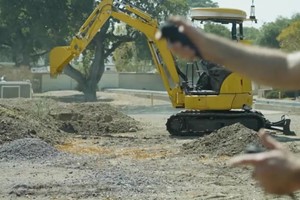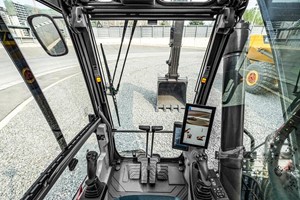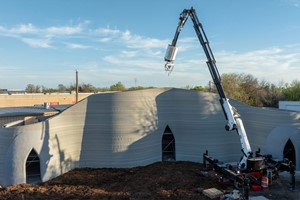Given the rapidly rising investments in robotics and drones, why is the SPE Unmanned Systems Technical Section struggling to find volunteers willing to form a new board and keep the rest of the Production and Facility Community up to date on the opportunities and challenges in applying these new tools in the field or at construction sites?
In 2016, Accenture and Microsoft published the results of their Oil and Gas Digital Trends Survey forecasting the top areas of focus over the next 3 to 5 years and the fastest areas of growth over that same period.
In 2021, we should be well into the dark blue bars with the rapidly rising investments in robotics and drones showing growth rates exceeding those of artificial intelligence.
So, why is the SPE Unmanned Systems Technical Section (USYSTS) struggling to find volunteers willing to form a new board and keep the rest of the Production and Facility Community up to date on the opportunities and challenges in applying these new tools in the field or at construction sites?
Remotely operated vehicles (ROVs) have been used in offshore operations for about 50 years. I clearly recall the first time that
- I watched divers change a VX ring on a subsea wellhead, thanks to a subsea camera and lighting from a tethered ROV. Shortly thereafter, the ROV was able to anchor itself to the wellhead and do the job itself.
- I used a peephole in a blast door at an airport to watch a robot very carefully cut open an abandoned bag and scatter someone’s clothes all over the floor of a transfer lounge.
- I saw a downhole tractor demo at an oil show in Europe.
- I saw a minicopter perform a mapping project at a vineyard in British Columbia and shortly thereafter, watched a similar drone perform a heat emissions survey for a thermal project.
- Our project team investigated the feasibility and approvals required to use a long-range, fixed-wing, unmanned aerial vehicle (UAV) to undertake a pipeline leak-detection survey.
Since the turn of the century, we have seen a plethora of unmanned vehicles joining the E&P workforce.
However, many of us are still unsure about the capabilities, competency, and/or limitations of these tools.
Moreover, there is a new array of TLAs (three-letter acronyms) to look up, learn, and get into the PetroWiki glossary such as
- AUV, autonomous underwater vehicle, which is fundamentally different from UAV, unmanned aerial vehicle
- RGR: Rugged ground robots in oil and gas (but a Google search shows us that for many others this TLA might stand for robotic gait rehabilitation)
- ROS: Robot operating systems
- UID: Underwater intervention drone
And now, let’s move to four-letter acronyms such as
- E-ROV: Empowered remotely operated vehicle with Ethernet control via a smart buoy
- OWCR: offshore worker class robots
- RaaS: Robots as a service to the oil and gas industry
- RFID: Radio frequency identification
- USYS: Unmanned systems (but shouldn’t it be USys?)
As a generalist and potential advisor to end users, I feel that I am being asked to take a drink from a firehose right now. In the past 6 months, there have been lots of articles on the web, JPT, technical papers, and great posts on my LinkedIn feed about
- ANYmal walking robots being used for various E&P operators, including Petronas in Malaysia
- Argonaut, the tracked robot, being tested offshore by Total
- E-ROV, developed by Oceaneering International, being tested by Equinor
- Gemini ROV, developed by TechnipFMC, being deployed by Shell in the Gulf of Mexico
- Hydrones, combined ROV/AUVs developed by Saipem, being contracted by Equinor for Njord
Thanks to all who have been posting this information, but why is it not coming up on SPE Connect in the USYSTS blog or library?
For those working in operating companies and/or acting as Production and Facilities, DSEA, or drilling advisors to the end users, it's not about the hardware, control systems, software, or the specific manufacturer/service provider—it's about the solutions that these existing and new technologies bring to the oil and gas industry. There is clearly the potential to significantly improve our safety performance and/or reduce costs and risks if these mechatronic tools can increase the efficiency and more effectively perform more operations.
Surely, I can’t be the only one who thinks
- “That is so cool; I wonder when this is going to be presented at an SPE technical session by my section, region, or as a multi-time-zone webinar by the USYSTS?”
- “If I could get my supervisor or manager excited, maybe we could follow up with a visit to OTC in Asia, Brazil, or Houston, or to Offshore Europe in 2022, and/or to a service company facility.
This leads me to wonder why there aren’t more volunteers lining up to help revitalize the board of the SPE Unmanned Systems Technical Section.
The Unmanned Systems Technical Section was established in 2017 as a spin-off from the Drilling Automation Technical Section. The approved acronym is USYSTS (pronounced as the "uses" technical section ... cute, eh!). However, over the past few years, this seems to have evolved with many people (including me from time to time) opting to use the first letters of each word, or UMTS. (To quote William Shakespeare, from Romeo and Juliet: “A rose by any other name would smell as sweet.”
The purpose of this technical section is to promote the exchange of information, technology, and development of understanding/competence in the use of unmanned systems by the petroleum industry. The envisioned jurisdiction included remotely or autonomously operated air, ground, and marine mechatronic unmanned vehicle systems with applications in the upstream, midstream, downstream, and service sectors of the petroleum industry.
The definition of “unmanned” systems typically implies a vehicle without a human on board, although there will be exceptions, such as autonomous ground vehicles that carry passengers. (A fully automated onshore drilling or service rig with walking legs or a dynamically positioned drillship might technically be considered mechatronic vehicles. However, “automated rigs” were explicitly excluded from the remit of this technical section.)
Any professional member of the Society of Petroleum Engineers in good standing with interest in the subject (and PhD student members of an SPE Chapter) can be a member of the USYSTS at no incremental cost by signing up via SPE Connect. Other student chapter members studying for an undergraduate or master’s degree have “read-only” access to the materials on the Section’s website.
Normally, 20 to 30% of the technical section’s board would be elected each year. However, most of the current board members have either reached the end of their 4-year term or are unable to continue in their current role in 2021–2022 for various reasons. It is, therefore, proposed to hold a Virtual Special General Meeting and Election in December 2021 to establish a new board. The current chair, Ed Tovar of InTechSys LLC, will remain on the board as the past-chair/treasurer and advisor to the new board members.
Bob Pearson














